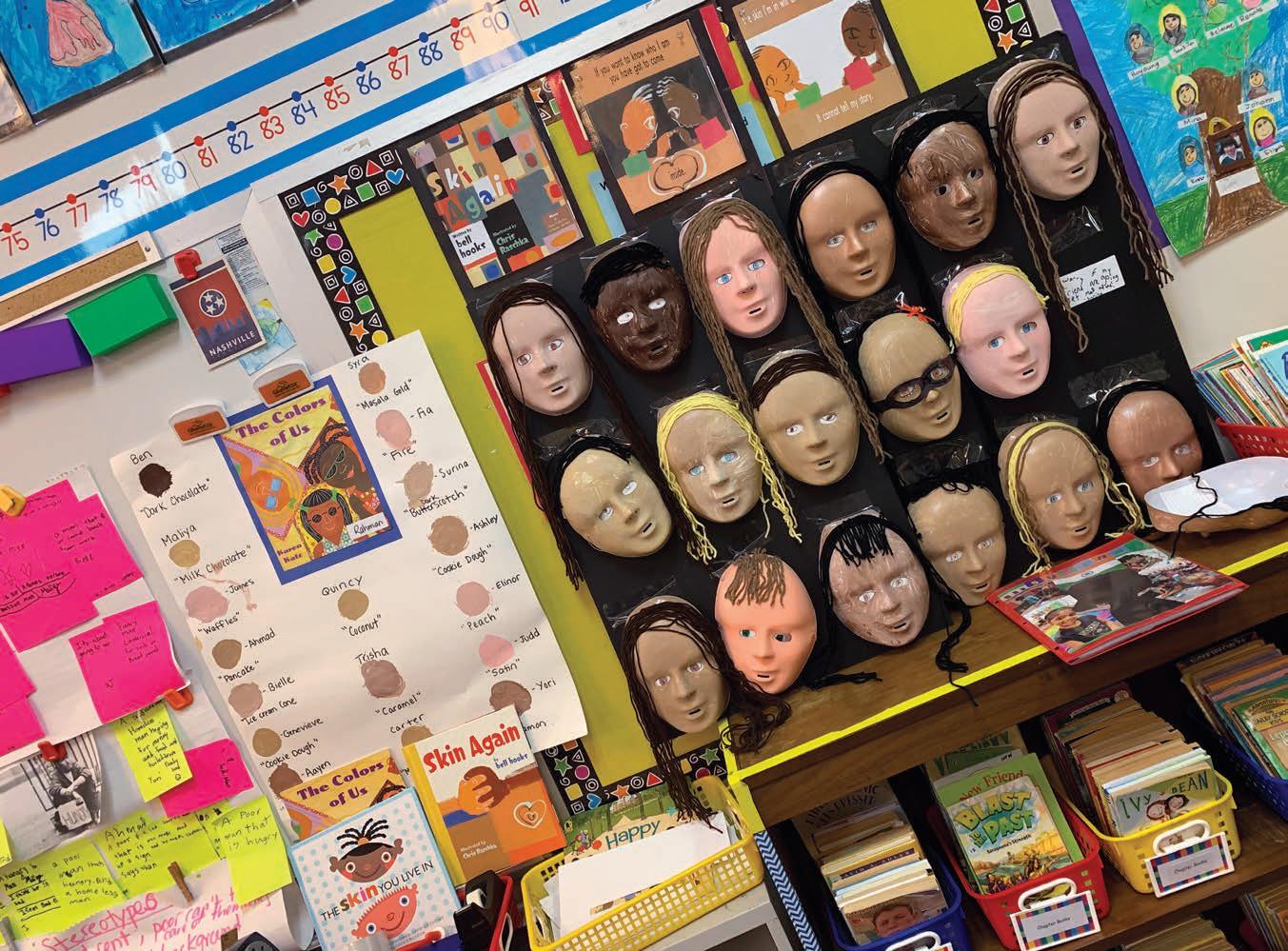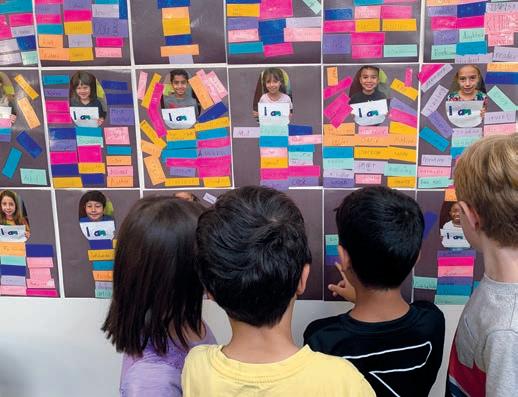
9 minute read
Understanding Identity
Young students understand diversity, inclusion through self-exploration
By Lower School Teachers Lizzie Ammerman, Nabilah Rahman, and Victoria Roca
“Potato parfait skin” and “eyes that can taste what they see” are some of the ways Lower School students describe themselves in projects during the division-wide study of identity that began in fall 2019 — a natural extension of the work already done around diversity and inclusion. There were cultural potlucks, cardboard name cutouts, puzzles explaining students’ hobbies & personalities, self-portraits, and an identity quilt. How did three faculty develop this curriculum and make it age-appropriate K-4? How has it benefited students? Why is it important for students to learn about their identity including social-economic status, race, and gender differences?
Peach pie, sparkling faculty met regularly to explore chocolate ice cream, how diversity and inclusion work grilled chicken salad, and might be more systematically sandy beige are a few of the incorporated across the curnames that second graders used riculum. To that end, teachers to describe their skin colors after curated books, created a scope reading “The Skin You Live In” and sequence, and developed by Michael Tyler and David Lee activities that would best support Csicsko. Dollops of white, red, our youngest learners. yellow, and brown paints landed on each desk with students swirl- Knowing that children recognize ing until they felt they mixed differences in people and begin matches with their skin colors. to categorize them by those visTheir art projects were part of ible differences — such as skin Lower School’s identity unit for- color — as early as six months, malized in fall 2019 — a natural it was of utmost importance that extension of the work already Lower School educators spoke to done around diversity and incluLower School Teachers Lizzie Ammerman, Victoria Roca, and Nabilah Rahman those differences and reflected sion in Grades K-4 for young positively on them. Students who minds to begin to understand socioeconomic status, race, and are not given ample opportunities to explore the way in which gender differences as well as concepts like privilege and discrimi- they know themselves, and how society may portray those same nation. Students gain a better understanding of themselves, their identities, can easily fall prey to negative stereotypes and biases, classmates, and their communities, and their lessons manifest whether about themselves, or those different than themselves. In themselves in cultural potlucks, cardboard name cutouts, puzzles order for students to grow into adults who welcome diversity and explaining students’ hobbies & personalities, self-portraits, and who seek to create civil discourse with those of differing perspecan identity quilt. tives, our youngest students must explore these concepts early and often. In December 2018, Nashville hosted the National Association of Independent Schools’ People of Color Conference, a conference Over the summer, three of the classroom teachers from the PoCC for professional development and networking for educators of group worked together to create a binder of morning meeting color and allies of all backgrounds. Teachers from all divisions lessons, read aloud discussions, and resources exploring identity took advantage of the proximity to attend powerful sessions on systematically across all grade levels. As Second Grade Teacher diversity and inclusion, and brought ideas for growth back to the Victoria Roca, Second Grade Teacher Nabilah Rahman, and First classroom. Over the next five months, a group of Lower School Grade Teacher Lizzie Ammerman were well suited to recognizing

Images, books, and posters of students’ reflections on their identities fill Nabilah Rahman’s second-grade classroom. Most powerful are face masks students painted of themselves. Beneath each mask, students wrote what people would not know about them through physical appearances alone.
both the importance of a defined skill set of awareness and understanding of diversity, as well as the challenge of implementing a new curriculum into an already established program of elementary education. Head of Lower School Amy Woodson and Director of Diversity and Community Life Roderick White supported the trio by filling classroom shelves rich with books to support teaching young children about identity and providing inservice time for teachers to go over the new curriculum. Lower School faculty were also given tips for facilitating open and thoughtful discourse that didn’t shy away from teaching hard history or concepts of power and privilege.
Beginning in August 2019, all Lower School students explored facets of identity, including name, family, race, ethnicity and culture, religion, socioeconomic status, abilities, and gender through picture book read alouds, and thoughtfully crafted discussions. “The identity curriculum strengthened my classroom community in numerous ways. Students built trust with others by exploring and discussing topics that have been on their minds but may not be something they have spoken about openly before. Students gained a stronger sense of self and an understanding of the differences that surround us and the importance of accepting and appreciating our differences,” explained Third Grade Teacher Kyleen Shyer. “Additionally, it created a new awareness in them about the need to carefully analyze our history as well as events that are currently happening.”
Much of the identity curriculum happens in the conversations after a read aloud. One of the big questions we ask at the beginning of this identity study is, “What does it mean for our community
that we have differences in our identities?” We explore that question through various activities with a focus on understanding one another as a cohesive group and how our identities make us unique.
Kindergartners filled shoe boxes with items that represent their family and culture to create cultural boxes. Students brought in objects used in Diwali and Kwanzaa celebrations, children’s books written in a variety of languages, and items from their family’s country of origin. Kindergartners loved sharing about their families and their classmates were excited about finding commonalities.
Some classes used cultural potlucks to discuss family traditions and religious holidays, sharing why they are meaningful to them and their identities. Other classes filled their plates using crayons, markers, and colored pencils. Flags showed the cultural origin and showcased the diversity of the food we enjoy and the places to which we are connected in some way.
Parents participated in the Lower School identity unit too, sharing about their families, name stories, paths of immigration, and religious and cultural traditions. This home connection furthered the impact of the curriculum and shed light on aspects of students’ family cultures that are not always discussed at school. Lower School parent Jaime Bruce, who has for many years engaged in conversations with her children surrounding the difference of their skin colors, opted to participate in a parent night aimed at giving parents the tools to have tough conversations using the same language teachers were using in the identity curriculum. “The implementation of the identity curriculum in the Lower School, so thoughtfully created by Ms. Ammerman, Ms. Roca, and Ms. Rahman, has given common ground and new fire to this highly important, ever evolving conversation in my home. The language used at school about identity has allowed my children to ask questions in a different way, using new language. It has given them a different level of confidence in choosing just the right shade of skin for their self portraits. It has encouraged us to read about African and African American heritage. It has changed the way we buy books for night time reading,” said Bruce, mother of Parks Holliman ’30 and Elliott Holliman ’32. “The examples are too many to list, but the result is a huge boost in confidence for my children as they navigate their own identities and a platform shared between home and school for a mom navigating the challenges of supporting identity growth in her children.”
This past winter, Lower School also hosted “Exploring Identity with Young Children,” a parent education workshop for families to explore classroom activities and read and discuss the books used as part of the curriculum. Parents practiced how they should talk with their children using real conversations between students and their teachers that have happened while at school.
Teachers celebrated this new opportunity for community building. They worked together to create a display of learning that showed the larger school community what it means to embrace and celebrate diversity through an “Identity Fair” that took place during parent teacher conferences. The fair showcased students’

During the identity unit, Lower Schoolers learn about differences in religion, culture, skin color. Classmates read over the work of their peers defining themselves.
Using conversations that have happened in Lower School classrooms, parents practice how to speak with their children about history and current events during a parent education workshop held February 6, 2020 in the Sperling Cafeteria.


USN parent Vandana Abramson watches the identity video created by her daughter Annika ’29 during the Lower School Identity Fair in spring 2019.
knowledge of themselves and also highlighted how they applied that knowledge of themselves as members of a diverse community.
Reflecting on their kindergartner’s experience, alumni and parents of David Perry ’32, Mollie Shmerling Perry ’03 and Bobby Perry ’03, noted, “USN’s identity curriculum was an incredibly thoughtful way for our family to explore its varied background. We couldn’t be happier with the added perspective that the curriculum gave all of us.”
As Lower School Teachers prepared to start the 2020-2021 academic year remotely, their commitment to the curriculum remained strong.
“Nothing could be more important in a pandemic than students understanding how they connect, belong, and are significant,” noted First Grade Teacher Marty Kennedy.
Indeed, a summer filled both with the disconnection that comes from social distancing, and the trauma of police brutality and racial inequities highlighted by the murder of George Floyd, among so many others, highlights the grave importance of this work. When our youngest students truly know themselves, they can also deeply know others who are different from them, and pave the way for courageous conversations and actions that make our society better, one relationship at a time. nn
Identity Books
Lower School faculty used these books for read alouds. They are available to the USN community in the Hassenfeld Library. For the complete list of books used for USN’s Identity Unit curriculum, visit usn.org/publications.
Alma and How She Got Her Name
by Juana Martinez- Neal (K-2)
The Name Jar
by Yangsook Choi (3-4)
Families
by Shelley Rotner (K)
A Handful of Buttons by Carmen Luque (1-2)
My Family, Your Family
by Lisa Bullard and Renée Kurilla (3-4)
The Skin You Live In
by Michael Tyler and David Lee Csicsko (K-2) Skin Again by Bell Hooks (3-4) This Is How We Do It by Matt Lamathe (K-4) What Do You Believe? by DK (K-4) Maddi’s Fridge by Lois Brandt (K-4) Don’t Laugh at Me by Steve Seskin (K-2) Jack, Not Jackie by Erica Silverman (K-4) They All Saw a Cat by Brenden Wenzel (K-2)
Voices in the Park
by Anthony Browne (3-4)
Come with Me
by Holly McGhee (K-4)








